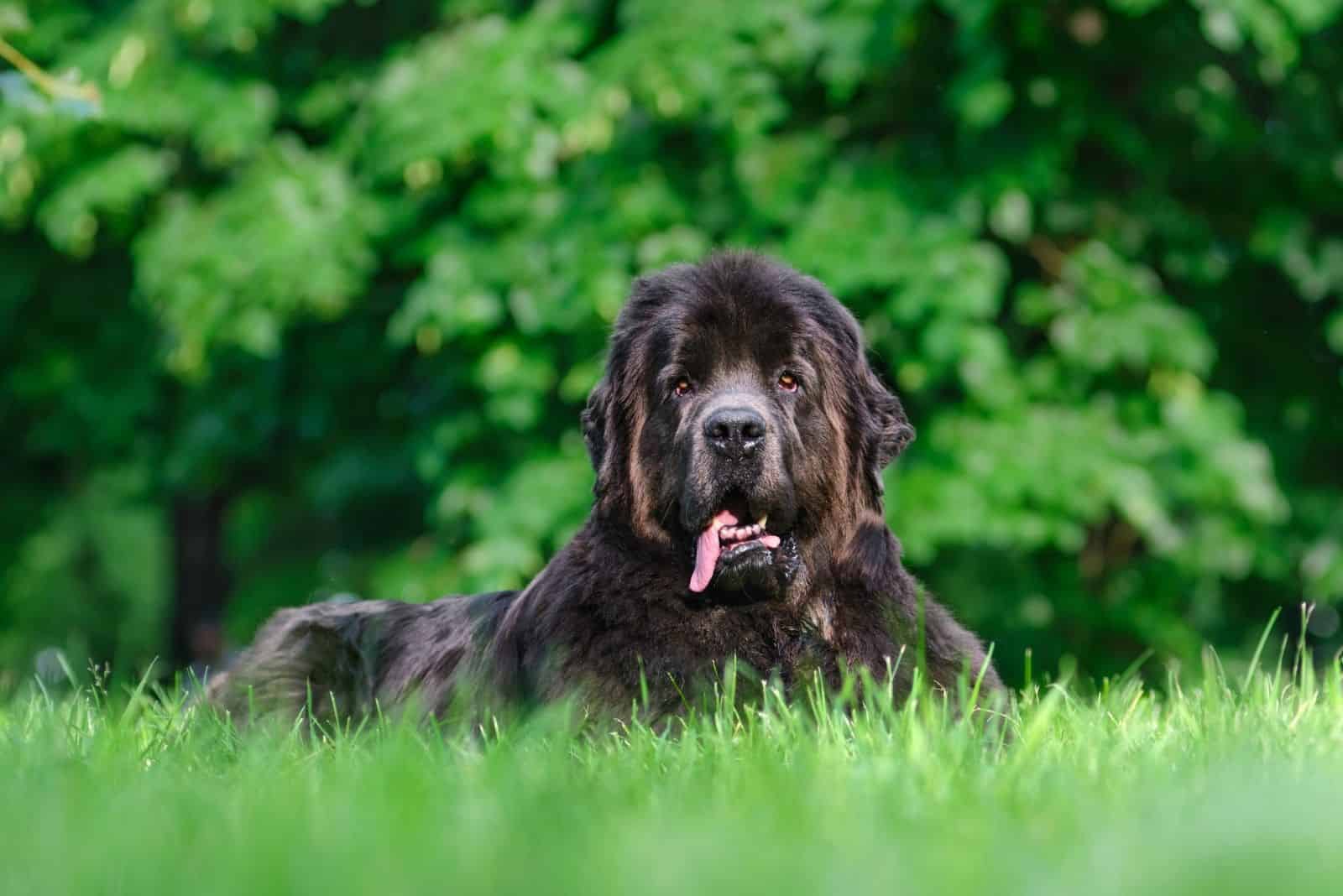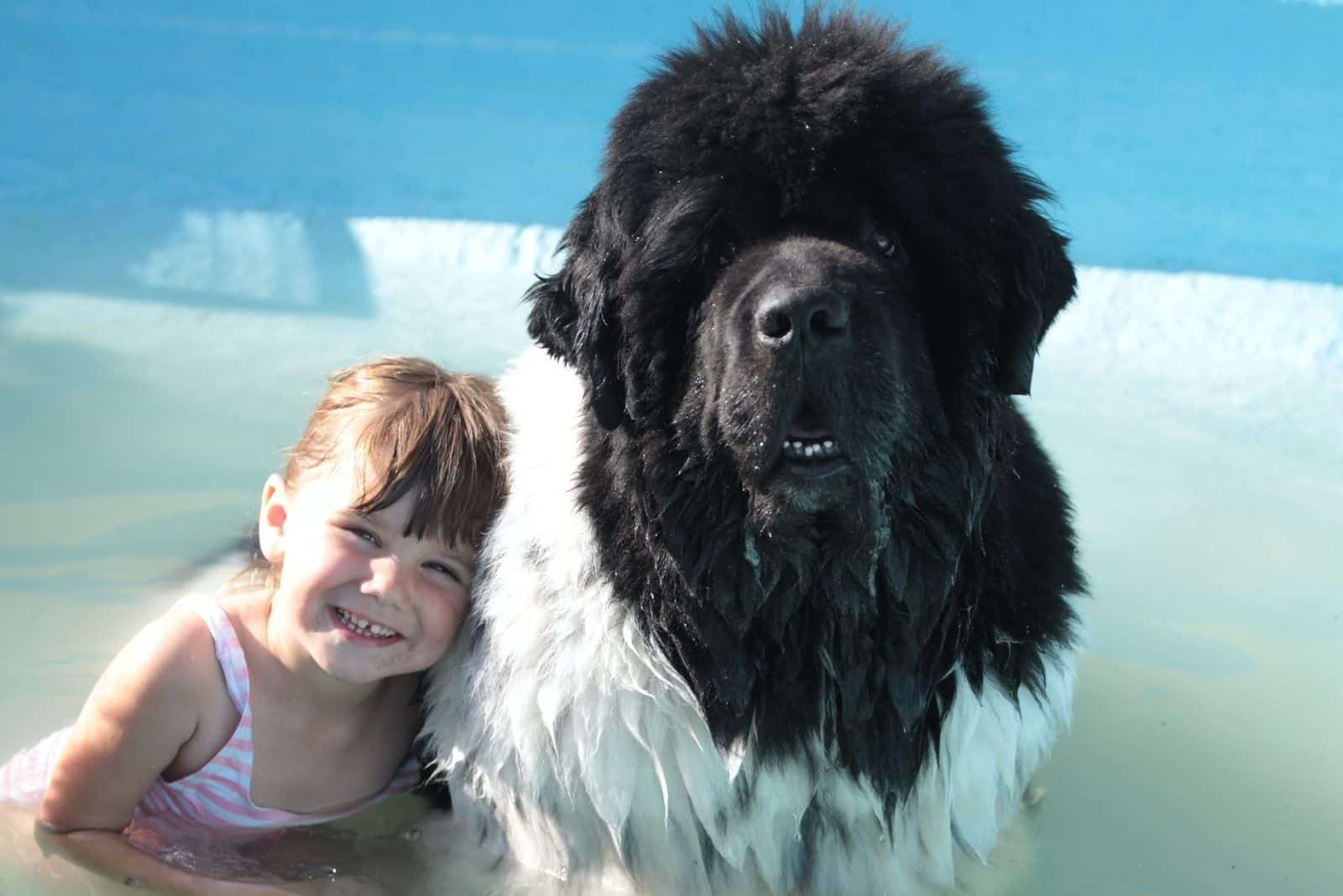The death of a beloved pet is the most tragic thing that can happen to any dog owner.
Our four-legged family companions don’t live as long as we do, and one day we’ll have to let them go.
There is some comfort in getting a pup with a fairly long lifespan. If you’re looking to buy a large, furry pet, you may wonder what the Newfoundland lifespan is and how long your future pet will be with you.
Newfoundlands are working dogs that originate from Canada.
They are sometimes known as Canadian St. Bernards because they do an excellent job as water rescue dogs and save plenty of lost people in the Canadian mountains and forests.
And if you’ve watched Peter Pan, you might have noticed Nana, Wendy’s large nanny dog. Despite the common misconception that Nana is a St. Bernard, the author J. M. Barrie confirmed that she is, indeed, of the Newfoundland breed.
The most well-known Newfoundland is Seaman, Captain Meriwether’s dog that went on the Lewis and Clark Expedition.
He was the only animal to complete the expedition.
The Newfoundland lifespan is nine years on average, which might sadden many aspiring owners.
Fortunately, there are plenty of things you can do to help your Newfie live a long and healthy life.
If you want to know what you can do to prolong the Newfoundland lifespan, as well as learn about certain health conditions these pups are prone to, this article is for you.
Newfoundland Dog Lifespan

Newfoundlands usually live between 8 and 10 years. This doesn’t mean they cannot live longer. However, this is the life expectancy of most of these pups.
Since this is a large dog breed, its fairly short lifespan shouldn’t come as a surprise. Research has shown that there is a link between a dog’s size and lifespan.
Unlike most mammals, dogs of all sizes take around the same time to grow to their full size.
This means that large dog breeds grow rapidly compared to smaller dogs. This speedy cell division can lead to plenty of issues, including abnormal cell growth and cancer.
Unfortunately, this has proved true for Newfoundlands, as these dogs are prone to all sorts of health issues.
Most Newfies will die from some type of disease – most common of which we’ll name a bit later.
At the same time, there is some difference in the Newfoundland lifespan when it comes to male and female dogs. Here’s why:
Female Newfoundland Lifespan
Female Newfoundlands grow to a height of 25–27 inches on average and weigh approximately 110 lbs. This makes them heavier than some humans!
These sweet-tempered dogs are beloved pups that, unfortunately, live a little less than males.
While this difference isn’t big – many people wouldn’t even notice it – you can greatly help your female Newfie by spaying her when she is around six to eight months of age.
Spaying can help your female dog by keeping her hormones in balance. Also, the vet will remove some of the organs that can develop tumors, such as the uterus and ovaries.
Male Newfoundland Lifespan
Male Newfoundlands are truly gentle giants. They stand around 28 inches tall, and they can weigh up to 150 lbs.
This makes them beasts among dogs! But don’t let this size fool you – males are even cuddlier and more loyal than females.
Also, males tend to live a tad bit longer than females. This is most likely because they don’t have a seasonal change in their hormones, as females do when they enter heat.
Neutering a male dog can help neutralize the chances of some health conditions, such as testicular cancer or diseases of the prostate.
This can also reduce the chances of aggression in your pup and lower the risks of a dog running away from home, which can lead to accidents.
However, there isn’t much proof that neutering helps increase a dog’s lifespan in any other way.
Landseer Newfoundland Lifespan

Landseers, also known as Landseer Newfoundlers, are tall, balanced dogs. They are popular in Europe and are one of the biggest long-haired breeds you can find.
Just like Newfoundlands, Landseers don’t live very long. They will rarely live longer than ten years.
What Is The Difference Between A Landseer And A Newfoundland
This question can get a bit tricky.
In many countries, such as the US and the UK, the Landseer is considered to be the same dog breed as the Newfoundland.
However, in many European countries, they are two separate breeds, and some differences do exist.
For example, Landseers are taller and have longer legs than Newfs, which is especially noticeable in males.
In fact, many Landseers resemble Great Pyrenees and Mastiffs more than Newfoundlands, so some people think they are a crossbreed.
While both have a water-resistant double coat, Landseers don’t have as thick an undercoat as Newfoundlands, so they won’t do as well in the cold as Newfies.
In fact, many Landseers lose their undercoat if they live indoors. This can lead to them not having as much of a heavy coat as Newfies.
Also, Landseers aren’t recognized by the American Kennel Club (AKC), but they can be registered within the Fédération Cynologique Internationale (FCI).
Newfoundland Mix Lifespan

If you’re looking for a family dog that looks like a Newfoundland but has a somewhat longer lifespan, you might be more interested in some of the Newfoundland crossbreeds.
Mixed-breeds tend to live longer than purebred dogs. This is because of something called hybrid vigor.
Dogs with hybrid vigor have had a wide genetic pool, so there are fewer chances of picking up recessive genes for many disorders.
At the same time, there are a few other advantages why you might want to pick a crossbreed instead of a purebred Newfoundland.
For example, if they are mixed with a Poodle, you might get something close to a hypoallergenic dog, or at least a dog that doesn’t shed as much.
Some crossbreeds might not drool as much, and others may be smaller, more comfortable for urban living.
Here are a few popular Newfoundland crossbreeds that you might want to check out!
Lab Newfoundland Mix Lifespan
The most popular Newfoundland mix is probably the crossbreed between a Newfie and a Labrador Retriever.
While nowhere near hypoallergenic, these dogs don’t need a lot of grooming and taking care of. Also, they usually won’t drool as much as purebred Newfoundlands.
Also, since Labs have a somewhat longer lifespan than Newfoundlands, you can expect this crossbreed to live a longer life.
In fact, the average life expectancy of this designer breed is up to 12 years, which is already better than what you’ll get with a purebred Newfoundland.
St. Bernard Newfoundland Mix Lifespan
This is yet another common hybrid breed that is very popular in Europe. By mixing a purebred St. Bernard with a purebred Newfoundland, it may seem like you’re making the ultimate rescue dog.
Unfortunately, both dog breeds suffer from similar health conditions as they have a somewhat similar origin. This means that, despite the hybrid vigor, these dogs won’t live much longer than purebreds.
In fact, the life expectancy of a Saint Bernewfie is just somewhere between 8 and 10 years, which is more or less the same as purebred Newfoundlands.
Newfoundland Poodle Mix Lifespan
The Newfoundland Poodle mix – also known as the Newfypoo – is a fairly new designer breed created with the intent to make a hypoallergenic rescue dog.
While most Newfypoos will still cause some issues for allergy sufferers, there are some advantages to having this crossbreed.
For example, these pups will still be huge and long-coated but with minimal shedding and drooling.
Also, they come in a huge range of colors thanks to the Poodle genes. You can find them in dark brown, white, sable, even tricolor! Their outer coat will be curly and non-shedding.
Another advantage of getting a Newfypoo is that this is a fairly healthy breed, especially compared to a Newfoundland, allowing this mixed-breed to live anywhere between 8 and 12 years.
Health Problems That Can Shorten The Newfoundland Lifespan

Many things can shorten your pup’s lifespan. This includes issues such as trauma, sudden illness, and genetic conditions that can affect a dog.
Most of them can be prevented, but unfortunately, some are inevitable.
Here are some of the most common health issues for Newfoundland dogs:
Dental Disease
Dental disease can rarely endanger a dog’s life, but sometimes this can happen.
In fact, this is the most common chronic problem in pets – it affects around 80% of all dogs by age two, no matter the breed!
Unfortunately, Newfoundlanders are especially prone to this health condition thanks to their large size and high amounts of slobber.
This will start with tartar build-up on your pup’s teeth. If you don’t take care of it by this stage, it can progress to the roots of the teeth and cause gum infections.
Believe it or not, untreated dental disease can shorten your dog’s lifespan by one to three years!
This is because the mouth is the gateway to the respiratory and gastrointestinal systems.
As time goes one, dental disease can lead to tooth loss and even damage to the kidneys, joints, liver, and heart!
Clean your pup’s teeth regularly at home, and take him to the vet for regular teeth check-ups.
This can help you not just save your dog’s breath, but maybe his life, as well.
Infections
Infections can negatively impact your Newfoundland lifespan – and unfortunately, this dog breed is susceptible to plenty of them, both viral and bacterial. This includes parvo, canine distemper, and rabies.
Fortunately, most of these infections are preventable through vaccinations. We recommend you stay up to date with your dog’s vaccinations, as this can help you save your pup’s life.
For example, if your Newfie spends a lot of time outdoors, he should get vaccinated for leptospirosis and canine distemper, as these are diseases they can get from wild animals.
All puppies should be vaccinated against canine parvovirus, and dogs that are housed in kennels should get vaccines for influenza and kennel cough.
Obesity
Obesity is another significant problem for this dog breed. In fact, it can shorten the Newfoundland lifespan for several years and kill them before their time.
Overweight dogs are prone to all sorts of metabolic and digestive disorders, joint problems, heart disease, and back pain.
They can commonly develop diabetes or other severe health issues that will require expensive and long-term treatments.
It’s important to resist a dog giving you puppy eyes. Treats should only be given as positive reinforcement, especially when dealing with a voracious eater like the Newfoundland. Also, leftover food shouldn’t be given to dogs.
Avoid giving your pup spicy food. The same goes for foods that are high on fat or sugar, such as whipped cream, sour cream, or sauerkraut. Learn more on this dog’s nutrition in our Newfoundland feeding chart.
There are plenty of other ways you can tell your dog you love him without making him overweight.
Give him a hug, play a game with him, brush his fur, or take him for a walk. This will not only let your dog know you love him, but it can also help him stay healthy for longer.
If you insist on giving treats to your Newfy, at least as a positive reinforcement, try giving him some healthy alternatives from your own kitchen. This includes paprika, fig newtons, and tuna.
Parasites
Just like any other dog breed, Newfoundlands can end up with parasitic infections, both inside and out.
Their skin can become infested with fleas, ticks, and ear mites, while hookworms, whipworms, heartworms, and roundworms can enter their system.
There are many ways a Newfie can come into contact with parasites. This includes drinking dirty water, being bitten by an infected mosquito, or even walking on contaminated soil.
Some of these parasites might even infect your or your family members, making it an even bigger concern!
To a canine, a parasite infestation can cause discomfort, pain, or even death. Yes, those little bugs and worms can shorten the Newfoundland lifespan, and they are no joke.
Test your puppy for parasites on a regular basis. Using preventive medication can also be a good idea, as this can ensure your Newfie pup can play outside without a worry or care in the world.
Eye Conditions
Newfoundlands are prone to several eye conditions, such as entropion (lid margin inversion) and ectropion (everted eyelids).
While eye conditions won’t directly impact the lifespan of a Newfoundland, they can become extremely painful and even cause blindness.
Some of these issues can lead to having to put your dog down to help ease his pain.
Heart Problems
There’s no need to explain how health problems regarding a dog’s heart can shorten its lifespan. Unfortunately, Newfoundlands can suffer from plenty of cardiac issues.
One of them is dilated cardiomyopathy (DCM), a disease that causes weakened heart contractions and lowers the pumping ability of the heart.
With the disease’s progression, the heart chambers become enlarged, causing one or more valves to leak. This ultimately leads to heart failure.
Subvalvular aortic stenosis (SAS), also known as subaortic stenosis, is another common heart defect found in Newfoundlands.
Dogs that suffer from it have developed abnormal tissue right below the aortic valve, which creates an obstruction.
SAS forces a Newfie’s heart to work harder than normal, leading to a heart murmur, which can lead to death.
Many of these diseases are genetic, but some may be caused by a lack of taurine in a pup’s diet.

Photo from: @martis_newfie
Skeletal And Ligament Issues
Some of the most common skeletal issues are hip dysplasia and elbow dysplasia. Both of these cause the joints to fall out of their sockets.
This condition can eventually lead to degenerative joint disease, which is a form of arthritis, and it usually affects smaller dog breeds, such as Cavalier King Charles Spaniel, Shiba Inu, and Jack Russel – but it can affect dogs such as Newfoundland.
Another skeletal issue is osteochondritis dissecans (OCD), which can affect the cartilage of the elbows, knees, and shoulders. It leads to the early maturation of cartilage.
There is also the possibility of a torn cruciate ligament, known as an ACL tear. In fact, this is probably the most widespread issue in Newfoundlands.
It leads to a tear of the cranial cruciate ligament, causing the tibia to slip forward out from under the femur.
Another common problem is a luxating patella or a knee that tends to fall out (luxate) from the kneecap (patella).
While this issue is usually seen in small breeds, Newfoundlands and some other giant breeds can get it, too.
Panosteitis, or pano, is an inflammatory bone disease that can be very painful. It usually affects Newfoundland puppies and is rarely found in older dogs.
Newfoundlands are also prone to Newfie neck.
This is an umbrella term that includes issues such as arthritis, a pinched nerve, or a slipped disk in the neck area. These conditions are common in dogs with large heads.
Most of these skeletal issues won’t directly impact the Newfoundland lifespan.
However, they can force you to put your pup to sleep, as they can be too painful if left untreated for a long while.
Read Also: When To Put A Dog Down With Torn ACL? 10 Factors To Consider
Skin Conditions
Newfoundlands are dogs that are prone to several skin conditions. This is usually due to allergies or improper grooming.
Newfies can be allergic to plenty of things, such as food, pollen, or certain chemicals. Seasonal allergies, for example, can lead to high veterinary bills.
If you don’t treat them, your pup will scratch excessively, which can cause hair loss.
Hot spots are another issue for this dog breed. This is a type of dermatitis that spreads very fast and can be tricky to treat.
They can appear due to parasites, bacterial infections, allergies, or unkempt coats. They can also be self-inflicted, especially if the dog is stressed out.
The Newfoundland breed is also prone to ear infections, which is expected from dogs with such large, heavy ears with narrow canals. Not to mention that their love for water isn’t very helpful!
Water helps the growth of bacteria and parasites, and both of these lead to ear infections.
Fortunately, they can be prevented if you take good care of your pup’s ears and clean them regularly.
Skin conditions won’t directly impact the Newfoundland lifespan. However, they can lower a dog’s immune system, which can have severe consequences.
Intestinal Problems
Many large breeds are prone to gastrointestinal problems. The most common of which is bloat.
Bloat is the result of two conditions: gastric dilatation, in which the dog’s stomach fills with fluid and gas, and then volvulus, or the twisting of the gas-filled stomach.
When the stomach twists, the stomach supply becomes cut off, causing the stomach to die off. This can lead to shock and death.
The second intestinal problem is megaesophagus, a condition that causes a dilation of the esophagus, causing it to lose the ability to move food further to the stomach. As a result, food accumulates in the esophagus.
Megaesophagus can be congenital and acquired, depending on when they appear. Congenital can be seen in puppies as soon as they start to eat solid foods, and acquired occurs later.
This condition prevents pups from growing properly, and adults might lose weight. This won’t directly cause death, but it will weaken the body and thus shorten the lifespan.
Another serious condition is inflammatory bowel disease (IBD). It is the result of a rapid increase of inflammatory cells in the dog’s intestine or stomach.
This prevents normal food digestion and causes severe pain for the animal.
So far, scientists don’t really understand IBD. It could be a disease or the body’s way of fighting underlying conditions.
Many things contribute to IBD in Newfoundlands, such as food allergies, parasites, bacteria, abnormal immune systems, and genetics.
Some gastrointestinal issues can disrupt the average lifespan of your Newfoundland. Others will simply cause pain and discomfort.
Neurological Conditions
The most common neurological issue in all dog breeds is epilepsy. It results in seizures that can happen once in a lifetime or become recurring.
Idiopathic epilepsy is an inherited disorder that still isn’t entirely understood. It is believed to be caused by some underlying issue, such as kidney failure, liver disease, toxins, brain tumors, or brain trauma.
Degenerative myelopathy is a slow-progressing disease that causes loss of coordination and numbness of the hind legs. It can result in paralysis.
Epilepsy can sometimes be deadly, especially if the seizures last for too long. Degenerative myelopathy might force you to put your Newfie to sleep.
Cancers In Newfoundlands
Unfortunately, Newfoundlands are prone to developing cancer, which is one of the leading causes of death in this dog breed.
Most can be treated if diagnosed in time, which is why vet visits are so important.
Lymphoma is a cancer of the immune system’s lymphocyte cells. Lymphocytes are a type of white blood cell, and they play a crucial role in the body’s defense system.
Another cancer is osteosarcoma. It develops in a dog’s bone cells and can rapidly spread throughout the pup’s body.
It’s common in large breeds, and, unfortunately, there is no cure for this condition, but with proper medication, the Newfoundland lifespan can be prolonged.
Newfies can also get all other types of cancer, but these two are the most prevalent.
Blood Disorders
Blood disorders can also impact a Newfoundland’s lifespan. One of them is thrombopenia, a blood clotting disorder that is somewhat common in this dog breed. It can lead to blood clots.
Von Willebrand’s disease (vWD) can also be found in large dog breeds.
This disease prolongs bleeding time, so affected dogs are prone to nosebleeds and increased bleeding after surgical procedures or traumas.
Both of these conditions can lead to the death of your Newfie, so make sure you’re on schedule with those vet visits.
Immune System Health Issues
Newfoundlands are prone to hypothyroidism, which is caused by a thyroid hormone deficiency.
One of the reasons why this might happen is due to problems with the thyroid gland.
Dogs with hypothyroidism can become overweight, listless, and they might have bald patches of skin. This can negatively impact your pup.
Also, Newfoundlands can get myasthenia gravis, a disorder that is characterized by muscle weakness.
It affects the muscles’ ability to contract, reducing a dog’s strength. This won’t directly decrease your pup’s lifespan, but it can worsen his living condition.
Kidney Issues
Newfoundlands can get sick with certain kidney issues, the most notable being cystinuria. In fact, Newfies can suffer from a severe form of this genetic kidney defect.
In a normal kidney, cystine is reabsorbed within the tubules, and it is only present in the dog’s urine in small amounts.
However, in dogs with cystinuria, cystine and a few other amino acids don’t get properly reabsorbed, so the urine is full of them.
This leads to the formation of kidney or bladder stones.
Cystinuria is an inherited issue and, on rare occasions, it can be deadly. If anything, the passing of kidney stones is very painful for your dog.
Respiratory Issues
Fortunately, there aren’t many respiratory problems that can affect your Newfoundland. However, a severe one they can get is laryngeal paralysis.
This condition is the degeneration of nerves in the laryngeal cartilages in the dog’s throat. These cartilages are responsible for controlling the airflow to and from the trachea.
In laryngeal paralysis, the trachea cannot open properly, so it cannot prevent aspiration of water and food. This can lead to airway resistance.
What Can You Do To Prevent Health Problems?

In most cases, you can help your Newfoundland puppy live a long and healthy life just by following common sense – the same way as you would with people.
Make sure your pup gets plenty of healthy dog food, brush his teeth and coat, and go to the vet for regular check-ups and if you suspect anything is wrong.
Stick to your schedule for vaccinations and examinations, and don’t skip vet visits just because it looks like your dog is doing okay.
You might also want to sign up for pet health insurance. Newfoundlands are a dog breed with plenty of health issues, so chances are you’ll end up getting back what you paid for.
Not to mention this will save you the risk of not having the funds to take care of your pup.
Make sure you have a routine with your Newfie, as this can help him live a long life and stay healthy. This includes a proper diet and exercise regime.
Supervise your pet all the time. Don’t keep the doors open, even block off rooms with dangerous things for them. This way, you’ll keep him out of trouble.
Brush your dog’s coat at least once a week, although you can do this more often if you think it’s necessary.
Keep in mind that Newfoundlands have plenty of loose hair during shedding seasons, and at this time, you should brush them daily.
Clean your Newfie’s teeth twice a week and their ears once a week.
These dogs are full of energy, so regular exercise is a must! Not to mention that a lack of exercise can lead to boredom, and this can lead to destructive behavior.
A good activity idea is swimming. Newfies love water!
Also, this dog breed is sensitive to warm temperatures, so make sure you avoid walking him if the temperatures are too high.
We’ve mentioned this before – don’t give your pup human food! Dog food is made for a reason, and you need to stick to it.
Also, make sure you give him food that’s appropriate for his age.
However, the most important thing for a Newfoundland lifespan is to get your dog from a reputable breeder.
Responsible breeders conduct all sorts of health screenings to ensure they are producing healthy dogs.
This lowers the chances of genetic conditions, meaning you’ll increase your chances of getting a healthy pup. To find some reputable breeders, check our list of 5 trustworthy Newfoundland breeders in Ontario and also list of 8 reputable Newfoundland breeders in the UK!
If you decide to save money on your dog and get your new puppy from a backyard breeder or a pet shop, you may end up forking out a lot of cash on huge medical bills.
Not to mention the stress of having to watch your beloved family pet go through a severe disease.
If you aren’t certain where to find a reputable breeder, you can always contact the Newfoundland Club of America for recommendations. They will point you in the right direction.
Are Newfoundlands Good Pets?

While Newfoundlands were bred to be rescue and guard dogs, they have become beloved family pets.
Their giant size only seems to make them more loveable, especially when combined with their fluffy fur and puppy eyes.
With a bit of proper socialization and obedience training, Newfies can also be great nanny dogs and companions for your kids.
Don’t let their huge size fool you – they are gentle dogs that love their owners.
Unfortunately, they are prone to many health issues that cause the Newfoundland lifespan to be very short, especially when compared to many smaller breeds.
This seems to be the price of having such an adorable family dog with you.
While you have to prepare for the inevitable, you should also be aware of some things you can do to help your pup live as long as possible, and this includes feeding them a proper diet, regular exercise, and other tips we have listed.
So, should you get a Newfoundland? This decision is up to you. Not everyone can deal with having so little time with their best friend.
If you’re someone who doesn’t mind this, then go for it – you won’t be sorry if you get a Newfoundland puppy for yourself.
Read Next: 9 Newfoundland Colors With Pictures: Choose Your Favorite!

